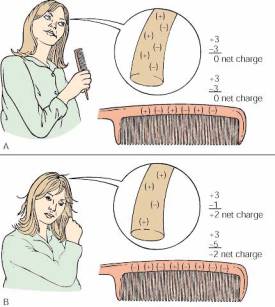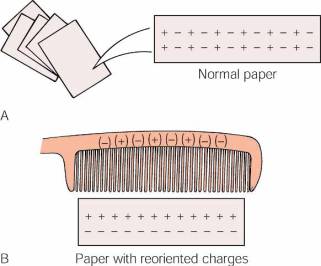
Surely you have noticed that static electricity can cause things to stick together. The explanation for this is a movement of electrons from one thing to another. Allow me to use a comb and a piece of paper as an example.
It is fairly dry today. As I comb my hair, the rubber comb picks up electrons from my hair. This gives the comb a negative charge and my hair a positive charge. Unlike the lady shown in the illustration below, my hair did not stick out too badly. Notice how there was no overall change in the number of TOTAL protons and electrons. While I was in the bathroom I grabbed a small bit of toilet paper. As I brought the comb toward the paper, the paper jumped up and stuck to it.

While I was in the bathroom I grabbed a small bit of toilet paper.
As I brought the comb toward the paper, the paper jumped up and stuck to
it. Why? The negative charges on the comb repelled the electrons in
the paper. This left the positive
charges near the comb. The negative comb and the positive side of the paper
attracted each other and the paper stuck to the comb

Charging by induction. The comb has become charged by
friction, acquiring an excess of electrons. The paper (A) normally has a random
distribution of (+) and (-) charges. (B) When the charged comb is held close to
the paper, there is a reorientation of charges because of the repulsion of the
charges. This leaves a net positive charge on the side close to the comb, and
since unlike charges attract, the paper is attracted to the comb.
Please go to the following web site for more information on static
electricity:
http://www.regentsprep.org/Regents/physics/phys03/atribo/
Please watch Animation 5.1: Charging
by Conduction and Induction on your CD.